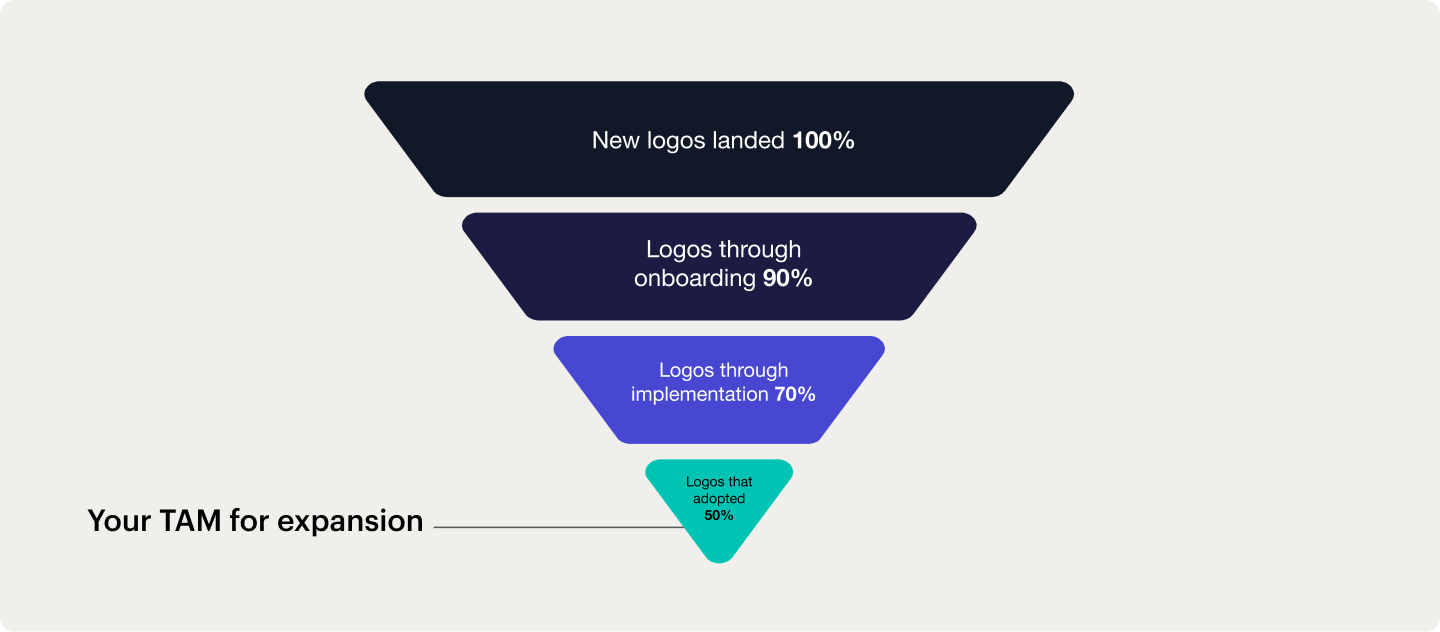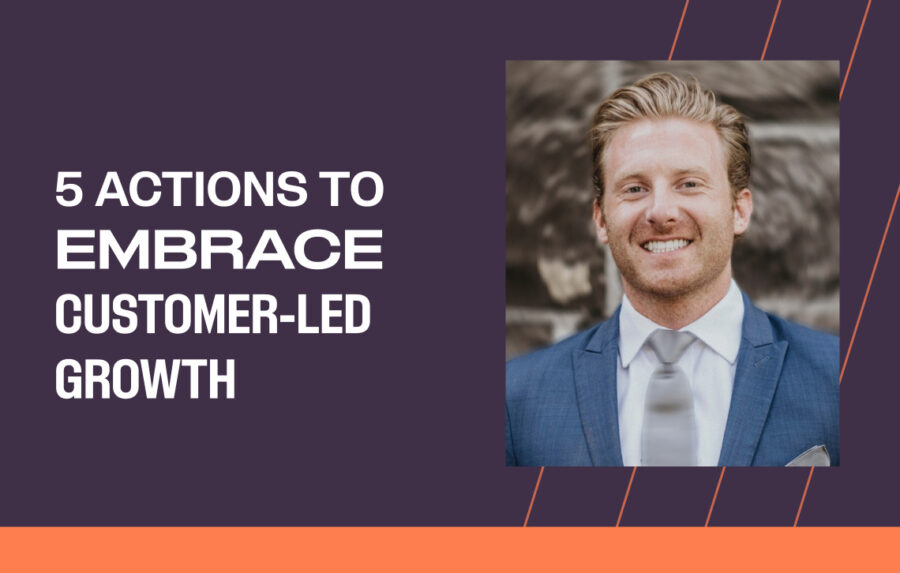Key takeaways:
- 97% of corporate leaders believe customer expansion is the key to driving revenue growth in their organization.
- But many organizations focus too inward—on internal operational tactics, rather than prioritizing the customer outcomes that drive customer-led growth.
- To drive customer-led growth, organizations need to assign ownership for expansion, align tactics to value drivers, measure post-sales funnels precisely, streamline communication post-sale, and use automation to create more clarity for teams.
For years, attainment was the sexiest word in SaaS.
With seemingly never-ending growth capital, organizational leaders focused almost exclusively on getting new customers—retention, upsell, and expansion would be handled by Customer Success.
But then the ground shifted from underneath.
The once endless capital dried up and more scrutiny came into deals; CFOs began asking why, for what value and how quickly, at the same time putting more accountability on CTOs for the efficacy of the tech stack. According to GTM Partners, 72% of companies experienced longer sales cycles in 2023.
Thus a new mantra came through: how can we be consolidated into, rather than away from?
The answer is customer-led growth.
We are living in a customer-led world
When we spoke to industry leaders, a whopping 97% of them believed expansion is critical to driving revenue growth in their organization.
We wholeheartedly agree.
The problem arises when you get to the “how” of customer expansion: 63% want a more strategic approach to expansion targeting, 40% are adding uplift into contracts at renewal, 32% are adding more SKUs, and 18% are collecting usage-based overages more frequently.
Notice a trend? All of these tactics are about the company versus the customer.

Pro tip: 72% of revenue comes from retention, expansion, upsell, and cross sell
To truly take advantage of the 72% of revenue that sits on the other side of a signed contract, we need to shift this mindset to make our expansion motion about our customer.
5 actions to become a leader in customer-led growth
1. Assign ownership for expansion success
You need someone who is accountable (and compensated) for expansion success. They need to go to bed at night and wake up in the morning thinking about it.
This person should also collaborate cross-functionally, building what I call a “Tiger Team”:
- Partner with marketing to plan customer campaigns and proactively marketing the value your platform offers to new prospects.
- Partner with sales and CS to include customer outcomes and desires as part of qualification and closing, to ensure a smooth handoff that enables great onboarding.
- Partner with product to understand how customer usage tracks to valued outcomes and how customer needs impact roadmap decisions and commercialization strategy.
2. Align expansion tactics to customer value drivers
News flash: usage is not value.
It is not uncommon that in many instances people are using products and not seeing value from it. They could absolutely love the product, but still churn because they cannot measure or demonstrate the value it brings to them.
When you plan for expansion, all levers need to be aligned to what the customer deems value:
- Are customer outcomes clear and documented in onboarding?
- How do platform metrics help tell the outcome and value story?
- Are you starting quarterly milestones with outcome stories?
- Do you keep a “regular pulse” on the business to ensure the goals at purchase are still relevant?
The good news is that you can have this motion ready, if you’re building business cases as part of the sales motion and carrying them through as guideposts from onboarding to post-sale.
When you take this outcomes approach, you’re naturally nudging a customer toward expansion through helping them achieve their goals.
3. Measure post-sales funnels with pre-sales precision
In sales, we measure lead volumes, segments, per rep attainment, and more. But who is applying that same level of measurement to the post-sale funnel? Do you know the percent of customers that make it successfully through onboarding? What customers are deploying additional use cases on their own? What is the expected definition for successful implementation? We should use this same level of precision with post-sale funnels.
Why? Because it helps you avoid wasted effort and find opportunities to improve your conversion at each step of the post-sale funnel.

For example, our data found that almost 10% of customers don’t even make it through onboarding and 30% cumulatively don’t make it past implementation into regular usage. If that’s the case in your company, you should be working to improve those processes before you spend any effort trying to upsell those customers.
At the bottom of the funnel—representing around half of your customer base, on average—are the people who love your platform and are getting value from it.
If you can measure every step in the funnel, you can figure out what these proportions are for your company, giving you a guide to the segments that are ready for expansion.
4. Tighten feedback loops on post-sale teams
The post-sale world is filled with multiple users, stakeholders, and goals.
To avoid this complexity becoming unruly, tighten feedback loops on post-sale teams—make sure documentation is concise and everyone coalesces around customer outcome. When you have that focus (and the data to back it up), you can have more informed conversations about actions and problem solving.
You have to build more of a journey, not just a set of tactics or initiatives. This is also where automation helps—see the next tip.
5. Automate to drive value
Your team is already asked to do more than they possibly could. Automate to save time and increase their capacity—so they can focus on all the other tasks that are getting pushed aside currently.
Things we think are great for automation:
- Data capture
- Ruting right tasks to right people
- Enabling CS teams to have value-driven conversations
- Customer sentiment analysis and activity capture
- Usage reporting
- Billing and account admin
All of these tasks need to be done, but are either routine or low-value. Let technology handle them so your post-sales team can focus on the hard stuff.
Go with your customer on the journey
Becoming customer-led doesn’t mean you forgo your core mission or product vision in favor of every custom request.
After all, your customer isn’t just buying your solution; they are buying your expertise with other customers in similar situations, as my colleague Karen Budell, CMO, eloquently explained on the Pipeline Visionaries podcast.
The key is to collaborate with your customer.
Talk about their overall needs and the reason they sought your solution. For things your product can do today, mutually come up with a plan—including the required inputs on the customer side—to make it happen. For anything your product can’t do, think about how it might fit either into the roadmap or how you can solve the problem via content, partnerships, or strategic referrals.
When you have this collaboration at the core, you unlock the sustainable growth that not only CFOs are after, but that drive sticky customer behavior—and revenue attainment.

